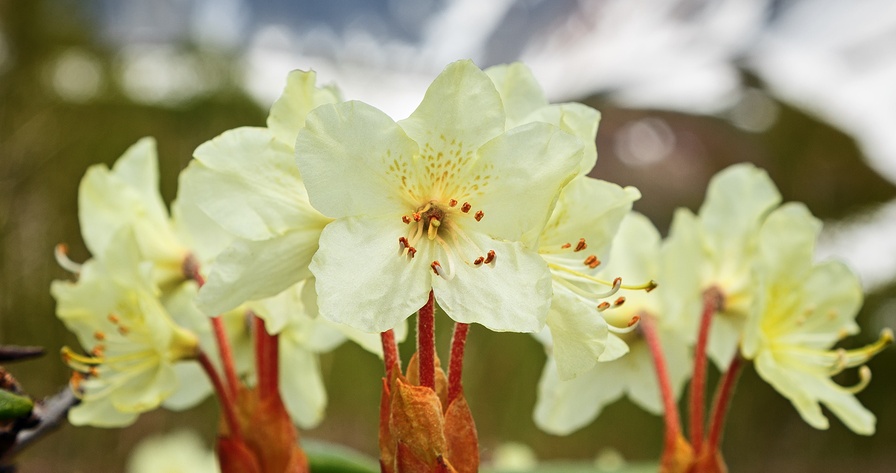Know Your Remedies: Rhododendron Chrysanthum (Rhod.)
 Common Names: Siberian rhododendron; golden flowered rhododendron; rhododendron aureum.
Common Names: Siberian rhododendron; golden flowered rhododendron; rhododendron aureum.
General Information
Rhododendron Chrysanthum (Rhod.) is a one of the remedies for rheumatic and neuralgic pains, especially of the joints. Those needing Rhod. are sensitive to barometric changes and can foretell the approach of a thunderstorm. Any sort of symptom may start or worsen before a thunderstorm – headache, pain, cough, diarrhoea, etc. – causing the sufferer to be anxious with the approach of a storm, even to the point of fear. Symptoms also worsen with wind or cold, wet weather but improve with warmth and gentle ongoing motion. The male gonads may also be affected with orchitis or epididymitis being common problems. Two unusual symptoms that may be experienced are that the person will only be able to sleep if their legs are crossed at the ankles, and the sensation of water being dashed against inner parts may occur.
Mind Problems
- Nervousness.
- Anxiety or dread before a thunderstorm.
Head Problems
- Headache with barometric changes and before thunderstorms.
- Toothache before thunderstorms.
Eye and Vision
- Neuralgic eye pain before a storm.
Gastrointestinal (Digestive) Problems
- Diarrhoea from fruit.
Limb Problems
- Gouty, rheumatic pains, especially before a storm or with barometric pressure changes.
- Pains that move from spot to spot but relieved by gentle and ongoing movement.
- Pain in the heels.
- Unable to sleep unless legs crossed.
Male Problems
- Orchitis and epididymitis (inflammation and pain in the testicles), especially the right.
- Pain and swelling in testes which starts on the right side but may then alternate sides.
- “Crushed” pain in testicle.
Where do I find it?
Rhododendron Chrysanthum (Rhod.) is available from our online store as a single remedy in either pills or liquid and as part of the following Complex (combination remedy): Joints – Stiff.
Home Treatment Guidelines
Acute, Self-Limiting Conditions
Conditions like colds or minor injuries, which are short-term and typically improve on their own, can be managed at home with homeopathy. However, in emergencies or if symptoms worsen, contact your healthcare provider.
Chronic Conditions
These home treatment instructions do not apply for ongoing issues, whether mentioned above or not, like persistent allergies or chronic pain. You should consult a qualified homeopath for a personalized treatment plan to achieve the best results with homeopathy for chronic conditions.
How to Take the Remedy for Acute Conditions
- Take one pill or five drops of the remedy. The frequency depends on symptom severity. As examples:
- For life-threatening symptoms, take every 1 minute and seek emergency help immediately.
- For mild symptoms, take every 4 hours.
- Stop taking the remedy once you feel better. Resume if symptoms return.
- If no improvement after four doses, choose a different remedy or consult a professional homeopath.
- For more details on dosing, refer to: How Often to Dose with a 30C Homeopathic remedy.
- For information on the different potencies, read: Guidelines on which potency to use
Additional Notes From Past Masters
Homeopathy is a 200-year-old system of medicine. Early homeopaths recorded detailed notes on how remedies worked, including initial tests, remedy relationships, and their experiences. These writings were shared to improve homeopathic practice and now offer fascinating insights into past uses of homeopathy. Here’s an example, edited and modernised for clarity, from Leaders In Homoeopathic Therapeutics (1898) by E. B. NASH M.D.:
Leaders In Homoeopathic Therapeutics by E. B. NASH M.D.
Rhododendron Chrysanthum (Rhod.)
Will naturally come in for notice while we are upon weather remedies. Like Dulcamara, its strongest characteristic is in its modality, “aggravation in wet stormy weather;” but Rhododendron is particularly worse before the storm, especially a thunder storm; after the storm breaks the patient feels better.
The aggravation before the thunder storm does not at all seem to depend on the coldness or dampness, but partially at least on the electric conditions of the atmosphere. This is like Phosphorus, Natrum carb. and Silicea. Rhododendron resembles Rhus toxicod. in that it is worse during rest and better during motion.
Again, the pains of Rhododendron, which are aggravated in damp weather, differ from those of Rhus toxicod. in that they seem to be deeper seated and are felt in the periosteum, as in the teeth, and in the bones of the forearm and tibia. These pains are not, however, confined to periosteal membranes, but attack also muscles and ligaments, so as to make it difficult to choose between these remedies.
So we have quite a list of marked wet weather remedies in Dulcamara, Natrum sulphuricum, Rhododendron, Rhus toxicodendron and Nux moschata. (Calcarea phosphorica, wet cold, especially melting snow).
Rhododendron seems to have an especial affinity for the testicles. They are swollen, with drawing contusive pains, which sometimes extend to abdomen and thighs, and they are very sensitive to touch.
The remedies most like it are Aurum metall., Clematis erecta, Pulsatilla, Argentum metall., and Spongia.
If the affection was of syphilitic origin we would prefer Aurum, especially if the case had been abused by old school mercurialization. If it came from suppressed gonorrhoea, Clematis or Pulsatilla; if of rheumatic origin, Rhododendron.
Of course all the case would come into the calculation when making up the perfect picture.




